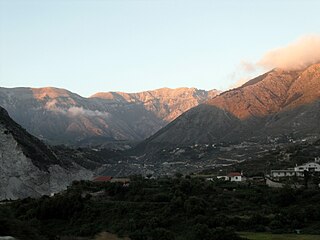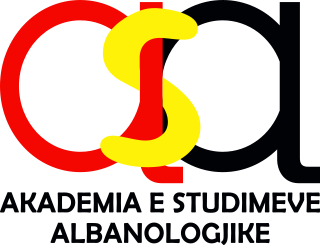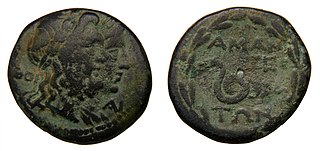Related Research Articles

Fier is the seventh most populous city of the Republic of Albania and seat of Fier County and Fier Municipality. It is situated on the bank of Gjanica River in the Myzeqe Plain between the Seman in the north, the Vjosë in the south and the foothills of the Mallakastra Mountains in the southeast. Fier experiences a seasonal Mediterranean climate affected by its proximity to the Adriatic Sea in the west.
Taulantii or Taulantians were an Illyrian people that lived on the Adriatic coast of southern Illyria. They dominated at various times much of the plain between the rivers Drin (Drilon) and Vjosa (Aoös). Their central area was the hinterland of Epidamnos-Dyrrhachion, corresponding to present-day Tirana and the region between the valleys of Mat and Shkumbin (Genusus). The Taulantii are among the oldest attested Illyrian peoples, who established a powerful kingdom in southern Illyria. They are among the peoples who most marked Illyrian history, and thus found their place in the numerous works of historians in classical antiquity.

Apollonia was perhaps the most important of the several classical towns of the same name. It was founded around 600 BC by Greek colonists from Corinth and possibly Corcyra, who established a trading settlement on a largely abandoned coastal site by invitation of the local Illyrians. Corinthian colonial policy seems to have been relatively liberal, and was more focused towards resource extraction so as to support the growing Corinthian population, rather than exploitation or expulsion of the local Illyrian population. Apollonia gradually gained political independence from Corinth and was organized as a polis under an oligarchic system. Aristotle describes Apollonia's oligarchy as a small Greek elite class, largely descended from the original colonists, ruling over a largely local Illyrian population.

Byllis or Bullis or Boullis (Βουλλίς) was an ancient city and the chief settlement of the Illyrian tribe of the Bylliones, traditionally located in southern Illyria. In Hellenistic times the city was either part of Illyria or Epirus. In Roman times it was included within Epirus Nova, in the province of Macedonia. The remains of Byllis are situated north-east of Vlorë, 25 kilometers from the sea in Hekal, Fier County, Albania. Byllis was designated as an archaeological park on 7 April 2003 by the government of Albania.

Amantia was an ancient city and the main settlement of the Amantes, traditionally located in southern Illyria in classical antiquity. In Hellenistic times the city was either part of Illyria or Epirus. In Roman times it was included within Epirus Nova, in the province of Macedonia. The site has been identified with the village of Ploçë, Vlorë County, Albania. Amantia was designated as an archaeological park on 7 April 2003 by the government of Albania.
Dimale or Dimallum was a town in southern Illyria in classical antiquity which was situated in the vicinity or within the territory of the Parthini, an Illyrian tribe. It was built on a hill of 450 m above sea level, in the hinterland of Apollonia, about 30 km from the eastern coast of the Adriatic. It is located in today Krotinë, Berat County, Albania.
The Parthini, Partini or Partheni were an Illyrian tribe that lived in the inlands of southern Illyria. They likely were located in the Shkumbin valley controlling the important route between the Adriatic Sea and Macedonia, which corresponded to the Via Egnatia of Roman times. Consequently, their neighbours to the west were the Taulantii and to the east the Dassaretii in the region of Lychnidus.

The Bylliones were an Illyrian tribe that lived near the Adriatic coast of southern Illyria, on the lower valley of the Vjosa river, in the hinterland of Apollonia. The Bylliones were firstly attested in epigraphic material from the oracle of Dodona dating back to the 4th century BC, and their koinon was firstly attested in a 3rd-century BC inscription from the same oracle. Their territory was trapezoidal on the right side of the rivers Luftinje and Vjosa, extending in the west to the Mallakastra mountains. The chief city of their koinon was Byllis. Another important centre of their koinon was Klos, an earlier Illyrian settlement later called Nikaia, as an inscription attests. The Bylliones also inhabited in the area of an ancient sanctuary of the eternal fire called Nymphaion.

Dukat is a community in Vlorë County, southern Albania. With the 2015 local government reform, it became part of the municipality Vlorë. The Dukat Plain covers an area of around 1,000–1,500 ha delimited by the Ceraunian Mountains and opened in the north towards the Bay of Vlorë on the Adriatic. Dukat traditionally belongs to the Albanian ethnographic region of Labëria.

The Academy of Albanological Studies is the main institution of albanology in Albania.

The Amantes were an ancient tribe located in the inland area of the Bay of Vlora north of the Ceraunian Mountains and south of Apollonia, in southern Illyria near the boundary with Epirus, nowadays modern Albania. A site of their location has been identified with the archaeological settlement of Amantia, placed above the river Vjosë/Aoos. Amantia is considered to have been their main settlement. The Amantes also inhabited in the area of an ancient sanctuary of the eternal fire called Nymphaion.
The Balaites were an ancient tribe in southern Illyria, modern-day Albania. The tribe is known from a number of Greek inscriptions, otherwise unmentioned among ancient written sources.
Illyrology or Illyrian studies is interdisciplinary academic field which focuses on scientific study of Illyria and Illyrians as a regional and thematic branch of the larger disciplines of ancient history and archaeology. A practitioner of the discipline is called Illyrologist. His duty is to investigate the range of ancient Illyrian history, culture, art, language, heraldry, numizmatic, mythology, economics, ethics, etc. from c. 1000 BC up to the end of Roman rule around the 5th century.
Shpresa Gjongecaj Vangjeli is an Albanian archaeologist and numismatist, who was the Director of the Institute of Archaeology at the Academy of Albanological Studies from 2008 to 2013. She is the recipient of the Vermeil Token from the French Numismatic Society and was appointed a Corresponding Member of the Archaeological Institute of America, both in recognition of her scholarship and services to numismatics.

The Culture of ancient Illyria or Illyrian culture begins to be distinguished by increasingly clear features during the Middle Bronze Age and especially at the end of the Late Bronze Age. Ceramics as a typical element is characterized by the extensive use of shapes with two handles protruding from the edge as well as decoration with geometric motifs. At this time the first fortified settlements were established. The local metallurgy produced various types of weapons on the basis of Aegean prototypes with an elaboration of artistic forms. The main tools were the axes of the local types "Dalmato-Albanian" and "Shkodran", as well as the southern type of double ax. Spiritual culture is also expressed by a burial rite with mounds (tumuli) in which a rich material of archaeological artifacts has been found.

Illyrian education is a term in the field of the history of education and pedagogical thought that denotes the totality of forms, organizations and educational institutions in the Illyria and among Illyrians. In the early periods, the education in Illyria and among the Illyrians was under the influence of Greek education, while later it was under the influence of Roman culture. Based on the latest scientific research and discoveries in various aspects of Illyrology: historical, archeological, epigraphic, linguistic, paleographic, etc., it has become possible to better summarize the Illyrian educational system. Illyrian education stretches over a period of time between the 8th century BCE, when the Illyrian culture began to flourish, and the 7th century CE, when the Illyrians are last mentioned in historical sources. In general, it can be said that education among the Illyrians was developed starting from a level of family and informal education towards an organized, institutional, and formal educational system.

Cratillus, son of Machatas was a 3rd century BC gymnasiarch from the ancient city of Nikaia one of the main settlements of the Illyrian tribe of the Bylliones.
Selim Islami was an Albanian archaeologist and historian from Sarandë who contributed to the development of Illyrian studies.
The History of education in Albania is a crucial component of the cultural, civilizational, and educational thought of the Albanian populace at large. While authentic scientific inquiry into the history of education and Albanian educational philosophy emerged comparatively late, Albanian researchers have made noteworthy contributions. Studies and monographs conducted by these scholars, particularly those undertaken in the latter half of the 20th century through the early 21st century, have illuminated a range of facets pertaining to this subject.
Skënder Anamali was one of the founders of Albanian archaeology. He made significant contributions to the field of Illyrian studies.
References
- ↑ Anamali, Skënder (1976). "Të dhënat mbishkrimore në disa qytete të Ilirisë së Jugut" [Données épigraphiques sur quelques cités de l'Illyrie du Sud]. Iliria (in Albanian and French). Tirana. 6: 127–135. doi:10.3406/iliri.1976.1261 . Retrieved 26 June 2022.
- ↑ Ceka, Neritan. (1987) Mbishkrime byline (Inscriptions bylliones). In: Iliria, vol. 17 n°2, 1987. pp. 49-121.
- ↑ Çomo, Bekim; et al., eds. (1986). Didaktika (in Albanian). Tirana: Shtëpia Botuese e Librit Universitar & Instituti i Studimeve Pedagogjike. p. 52.
- ↑ Dedja, Bedri, ed. (2003). Historia e arsimit dhe e mendimit pedagogjik shqiptar[The History of Albanian Education and Pedagogical Thought] (in Albanian). Tirana: Instituti i Studimeve Pedagogjike (Institute of Pedagogical Studies). p. 18.
- ↑ "Google". Archived from the original on 2022-04-27.